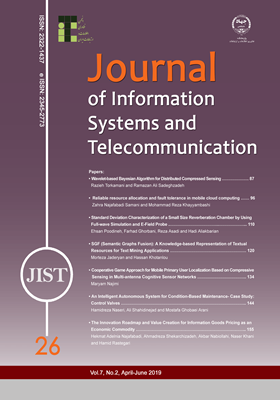-
-
List of Articles
-
Open Access Article
1 - Wavelet-based Bayesian Algorithm for Distributed Compressed Sensing
Razieh Torkamani Ramezan Ali Sadeghzadeh -
Open Access Article
2 - Reliable resource allocation and fault tolerance in mobile cloud computing
Zahra Najafabadi Samani Mohammad Reza Khayyam Bashi -
Open Access Article
3 - Standard Deviation Characterization of a Small Size Reverberation Chamber by Using Full-wave Simulation and E-Field Probe
Ehsan Poodineh Farhad Ghorbani Reza Asadi Hadi Aliakbarian -
Open Access Article
4 - SGF (Semantic Graphs Fusion): A Knowledge-based Representation of Textual Resources for Text Mining Applications
Morteza Jaderyan Hassan Khotanlou -
Open Access Article
5 - Cooperative Game Approach for Mobile Primary User Localization Based on Compressive Sensing in Multi-antenna Cognitive Sensor Networks
Maryam Najimi -
Open Access Article
6 - An Intelligent Autonomous System for Condition-Based Maintenance- Case Study: Control Valves
Hamidreza Naseri Ali Shahidinejad Mostafa Ghobaei-Arani -
Open Access Article
7 - The Innovation Roadmap and Value Creation for Information Goods Pricing as an Economic Commodity
Hekmat Adelnia Najafabadi Ahmadreza Shekarchizadeh Akbar Nabiollahi Naser Khani Hamid Rastegari
-
The rights to this website are owned by the Raimag Press Management System.
Copyright © 2017-2025







